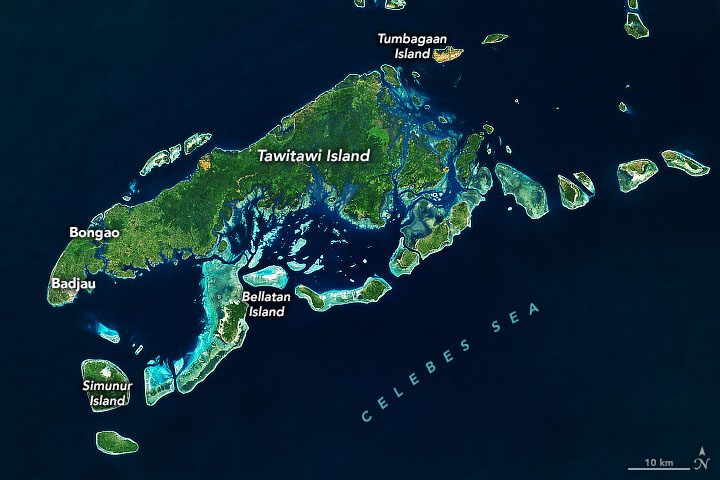Editor’s note: This Image of the Day includes the answer to the April 2022 puzzler.
Story by Kathryn Hansen(NASA) –A running hare. A jumping frog. A hungry dinosaur. Readers suggested that the arrangement of islands pictured here bears resemblance to such terrestrial creatures. But in this part of the southern Philippines, it is the aquatic life that sustains the livelihoods of many islanders.
More than 7,000 islands comprise the Philippines. Of those, 10 main islands and hundreds of smaller islets are part of Tawi-Tawi, a province of the Sulu archipelago in the country’s southernmost reaches. Located more than 1,000 kilometers (600 miles) southwest of Manila, Tawi-Tawi is closer to Malaysia than to many parts of the Philippines.
Most of Tawi-Tawi’s larger islands are visible in this image, including the island of the same name (also known as Tawitawi). Clouds frequently obscure the province from satellite views, so the natural-color image above is a composite of cloud-free pixels collected between 2013 and 2022. The images were acquired with the Operational Land Imager(OLI) on Landsat 8.
Notice the extensive areas of shallow water (light blue) around many of the islands, especially along the coasts of Bellatan and neighboring islands. This is the location of numerous seaweed farms. (There is another cluster of seaweed farms near Sitangkai Island, west of this image.) Tawi-Tawi province is the country’s main seaweed producer, earning it the nickname “the seaweed capital of the Philippines.”
Seaweed farming has taken place in Tawi-Tawi for more than five decades. The practice arose partly because the waters here are generally clear and mostly protected from storms and waves—unlike the typhoon-battered northern parts of the country.
The main species of seaweed farmed in Tawi-Tawi are collectively known as Eucheumatoids. If you have never heard of this type of red seaweed, you may have encountered its extract—carrageenan—in food and beauty products. Carrageenan is widely used for their gelling and thickening properties, and they are found in everything from ice cream to shampoo.
“In Tawi-Tawi, seaweed farming is not only seen as a source of livelihood,” said Richard Dumilag, a marine biologist at Sorsogon State University who studies seaweed. It also plays a role in maintaining the bonds of families, often extended families, “living close to their source of living literally in the middle of the sea.”
Fishing, agriculture, logging, and mining are other leading livelihoods for people across Tawi-Tawi. Notice the brown areas on Tawitawi Island’s north side and across much of Tumbagaan Island. These areas have been stripped of vegetation and mined for their nickel ores.
Offshore, Tawi-Tawi’s reefs support an array of commercially important fish such as snapper, grouper, and even rabbitfish. “Aside from being the home of seaweed farming,” Dumilag said, “Tawi-Tawi is also regarded as the area with the richest fish diversity in the heart of the Coral Triangle.”
NASA Earth Observatory image by Joshua Stevens, using Landsat data from the U.S. Geological Survey. Story by Kathryn Hansen. Read Full Article Here, Island Hopping in Tawi-Tawi

 Join The Club
Join The Club











